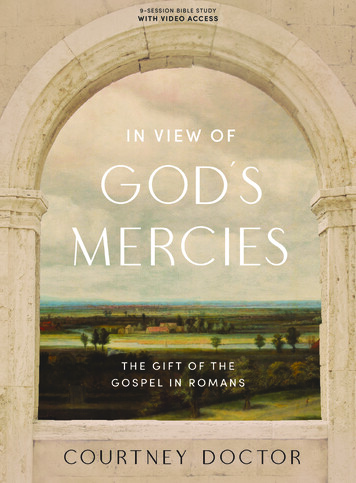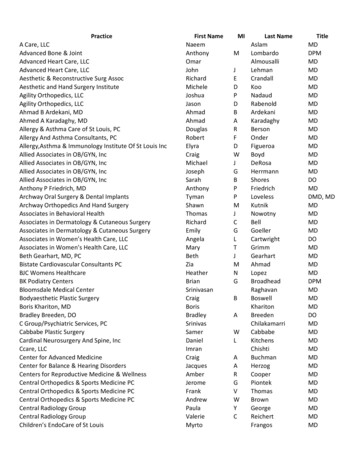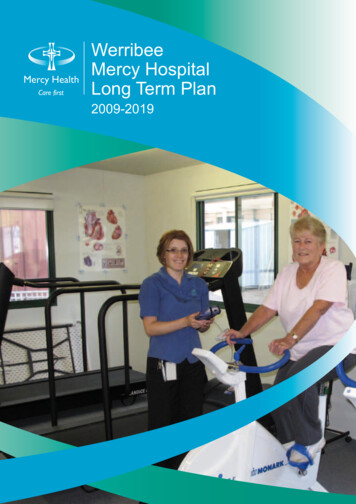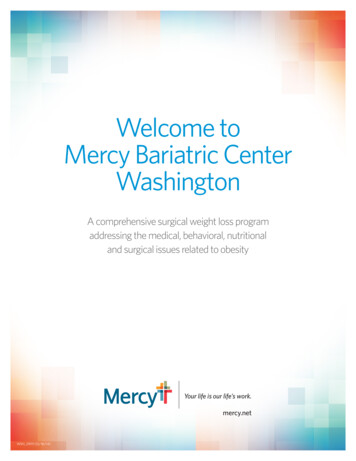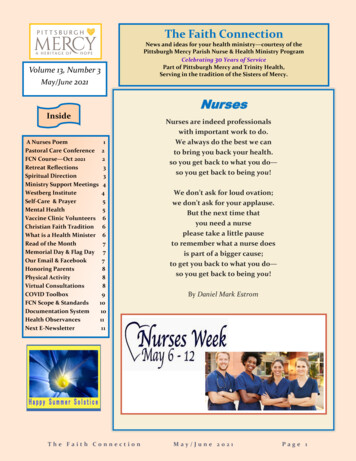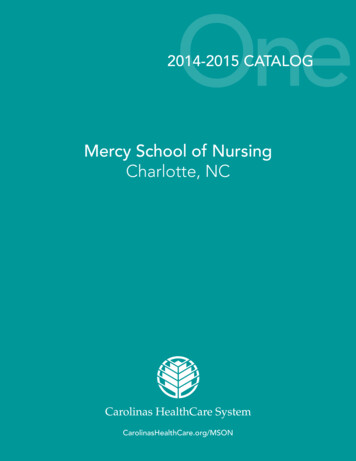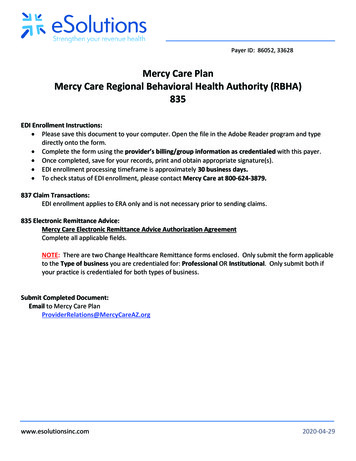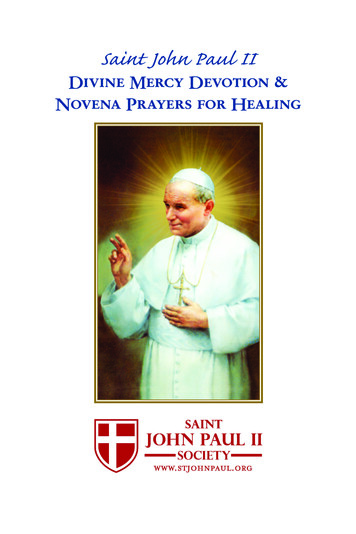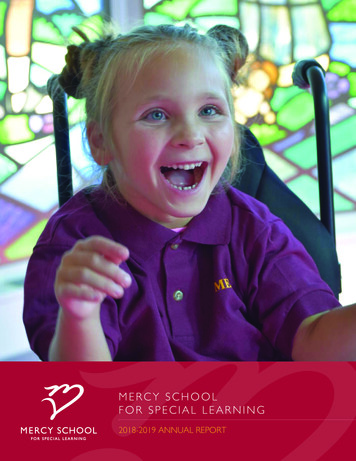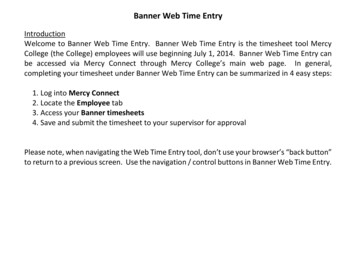
Transcription
2019RESEARCHREPORT
100yearsof Mercy HealthCelebratingOn 9 March 1920, St Benedict’s Hospital in Malvern —Melbourne’s first private hospital run by the Sisters ofMercy — was officially opened and blessed by the MostReverend Daniel Mannix, Archbishop of Melbourne.Coonil House in Malvern, which became the site of St Benedict’s Hospital.
The Sisters of Mercy established St Benedict’sHospital in the wake of the deadly pneumonicinfluenza pandemic, also known as the ‘Spanish flu’,which began in 1918. In our centenary year, MercyHealth is once again at the frontline of a global healthcrisis, caring for some of the most vulnerable peopleamid the coronavirus pandemic.St Benedict’s was housed in a rambling Victorianmansion, formerly known as Coonil House,surrounded by a vast expanse of established gardens.The Sisters bought the property in 1919 for 25,000and converted it to a stately and comfortable hospital,accommodating 70 patients and an operating theatre.On the day the Archbishop came to bless thebuilding, the leadlight panel above the front doorcaught his eye. It featured the word ‘Pax’, which isLatin for ‘peace’, to illuminate the Sisters’ desire thatall patients recovering at St Benedict’s “would berestored to peace in mind and body.” The Sisters’ holistic, compassionate and personcentred approach to care has continued to shapeMercy Health’s mission over the past century as theorganisation has established health, aged and homecare services across Australia. In this centenary year,Mercy Health is celebrating important milestones andhonouring the many people who have and continue towork tirelessly to provide exceptional care and bringGod’s mercy to those in need.The Founder of the Sisters of MercyCatherine McAuley was born in Dublin, Ireland in1778. Dedicating her life to caring for the poor,particularly women, Catherine established the Houseof Mercy in 1823 to house and educate poor women.In 1831 Catherine made her Profession of Vows andcreated the Order of the Sisters of Mercy.When I think we are done weseem to be beginning again.— Catherine McAuley1Mercy Health gratefully acknowledges the role that the Good Shepherd Sisters, Family CareSisters (Grey Sisters), Holy Spirit Missionary Sisters and the Knights of the Southern Cross(Victoria) have played in our mission to bring God’s mercy to those in need.Good ShepherdSistersFamily CareSistersHoly SpiritMissionary SistersKnights of theSouthern Cross (Victoria)1: Watercolour of Catherine McAuley, reproduced with the permission of artist Sr Marie Henderson RSM Priestley, S 1990. Melbourne’s Mercy: A History of Mercy Private Hospital, Hyland House Publishing, Melbourne, p. 27.
23Mercy in AustraliaThe Sisters of Mercy went on to found convents,schools and hospitals around the world. They arrivedin Perth in 1846, led by Mother Ursula Frayne, andestablished schools, hospitals and convents acrossAustralia.Since arriving in Melbourne in 1857, the Sisters ofMercy have been at the forefront of healthcare andadvocacy in Victoria. With the opening of St Benedict’sHospital, they established a reputation for excellencein care and hospitality that has grown in strengthto this day. The success of St Benedict’s enabledthe Sisters to open Mercy Private Hospital in EastMelbourne in 1934, Mercy Maternity Hospital (laterrenamed Mercy Hospital for Women) in 1971 andWerribee Mercy Hospital in 1994.In recognition of society’s changing needs, and tocontinue the Sisters’ mission of care, the organisationexpanded to care for older people. In 1997 we addedMercy Health Bethlehem Home for the Aged (Bendigo)and Mercy Place Rice Village (Geelong), followed bymental health services in 1998 and home carein 2007.You are invited to celebrate Mercy Health’s100-year milestone by sharing your mercymemories and stories on our centenary website:mercyhealth100years.com.au5462: Nurses from Mercy Private Hospital, circa 1940 3: The impressive Art Deco façade of Mercy Private Hospital 4: Mother Ursula Frayne (source: Institute of Sisters of Mercy of Australia andPapua New Guinea Archives) 5: Mercy nurses inspect the architectural model for the new Mercy Maternity Hospital, circa 1970 6: The nursery at Mercy Private Hospital, circa 1960
CONTENTS2Message from the Group Chief Executive Officer3Message from the Chief Medical Officer4Thank you to our supporters, partners andcollaborators7Academic Research and Development Committeesmall grants 20198Women’s and Children’s Services33Mercy Health welcomes Professor Christine East35In profile: Using innovation to pursue excellence36In profile: Improving health outcomes for womenand babies38In profile: Focusing on person-centred care40Ambulatory, Community and Allied Health Services43Surgical and Specialist Services46Medical, Subacute and Palliative Care Services48University of Notre Dame, Melbourne Clinical School49Mercy Mental Health51Aged Care54Projects approved by Mercy Health Human ResearchEthics Committee 2019Cover: Sister Hildegarde McAnuff demonstrating oxygen therapy to students (c.1960); Mercy Hospital forWomen researcher Caitlyn, from the Obstetrics, Nutrition and Endocrinolgy Group; Students in class in 1955Back cover: Preparation of neonatal intravenous solution under the laminar air flow hood (c.1981 – 82)Mercy Health Research Report 2019 1
MESSAGE FROM THE GROUPCHIEF EXECUTIVE OFFICERResearch is central to Mercy Health’s mission — to bring God’s mercy tothose in need. Our researchers are motivated by the desire to give hope toour patients, clients, residents, families and carers at every stage of life.The research endeavours of Mercy Health researchersare always a source of inspiration to me. Theemergence of a worldwide coronavirus pandemic at theend of 2019 has focused the world on the importanceof advances in academic and clinical research as neverbefore. It was as a result of the last global pandemic in1917 that the Sisters of Mercy established our healthministry in Victoria 100 years ago, and it is on the backof this that a great research, teaching and care legacyhas been built.With research across a range of fields, including fetaland newborn health, women’s health, paediatrics,mental health, aged care and allied health, Mercy Healthresearchers always keep in mind those who will benefitfrom the work they are doing.Mercy Perinatal seeks to give hope to those wishing tohave a family and continues world-leading education,practice and research into stillbirth, ectopic pregnancyand preeclampsia. Its focus is always on its goal ofbringing mothers and babies safely home.Research in the area of aged care continues to expand.With an ageing population from diverse backgrounds,understanding what we need to do to improve thecare and services we provide is essential. Similarly,continuing our research into mental health means thatwe can better help people living with mental illness andprovide the care and support they need.I would like to congratulate Alexis Shub fromthe Perinatal Research Group on her AssociateProfessorship. I also congratulate Harry Georgiou andhis team, the Biomarker Discovery Group, for theirachievement of obtaining a provisional patent for theirwork in the area of biomarkers of preterm birth. Pretermlabour is a significant healthcare issue globally and theirresearch seeks to improve outcomes for women andbabies affected.I would like to thank our academic, government andprivate sector research partners, and the communitieswe serve, for their ongoing and invaluable support.in Malvern, I am reminded of the words of the Founderof the Sisters of Mercy Catherine McAuley, “When Ithink we are done we seem to be beginning again.” Iam certain this is something Mercy Health researchersthink about every day as they continue their veryimportant innovation and discovery work.As we approach a milestone, marking 100 years sincethe Sisters of Mercy first opened St Benedict’s HospitalAdjunct Professor Stephen CornelissenGroup Chief Executive Officer, Mercy Health2 Mercy Health Research Report 2019
MESSAGE FROM THECHIEF MEDICAL OFFICERThrough a patient-centred approach, Mercy Health hopes our researchendeavours deliver better health outcomes for those we serve and care for.I am proud to present the Mercy Health ResearchReport highlighting the research projects, publicationsand achievements of the Mercy Health research teamsin 2019.I would like to acknowledge the clinical leaders andresearchers who are driving this incredible work. Thereare too many people to mention all of them individuallyin this short message, but I would like to thankProfessor Sue Walker, Professor Stephen Tong,Associate Professor Lisa Hui and their respective teamsfor their tireless work, especially in perinatal medicine.I also recognise the members of the Mercy HealthHuman Research Ethics Committee and I thank theChair, Tim O’Leary, for his leadership.Nursing and midwifery continue to flourish under theleadership of Professor Christine East, who joinedMercy Health in May 2019 as the inaugural Professor ofNursing and Midwifery.I acknowledge and thank Professor Peter Maher,Professor Peter Dwyer and Associate Professor PeterGrant, who have left their mark in gynaecologicalresearch over many years.Our medical libraries at Mercy Hospital for Womenand Werribee Mercy Hospital also contribute to theresearch effort and I thank the librarians who are alwaysready to help.Over the past few years, Werribee Mercy Hospital hasexpanded and grown. It is exciting to see the increasingamount of research they are conducting with even moreforecast in the coming years.Of course, our successes would not be possible withoutthe support of our funding bodies, donors, supporters,partners and collaborators. We thank you all.I encourage you to read this report to appreciate thedepth and breadth of our research.Associate Professor David AllenChief Medical Officer, Mercy HealthMercy Health Research Report 2019 3
THANK YOU TO OURSUPPORTERS, PARTNERSAND COLLABORATORSWe acknowledge and celebrate the partnerships we have forged in 2019 andour shared vision for a better future through research and education.4 Mercy Health Research Report 2019
Academic Research and Development Committee Small GrantsAustin Health Institute for Breathing and SleepAustin Medical Research FoundationAustralia New Zealand Gynaecological Oncology Group (ANZGOG)Australian Catholic UniversityAustralian Gynaecological Endosurgery Society (AGES) ResearchGrant ProgramCatherine McAuley CollegeClovis OncologyDeakin UniversityDiabetes AustraliaFerring PharmaceuticalsLa Trobe UniversityMonash Medical CentreMurdoch Children’s Research InstituteNational Health and Medical Research Council (NHMRC)Norman Beischer Medical Research FoundationNorth West Melbourne Primary Health NetworkNorthern HealthRoyal Women’s Hospital (Victoria)University of MelbourneUniversity of Papua New GuineaUniversity of Stellenbosch (South Africa)Department of Premier and Cabinet (Victoria)Foundation House: Victorian Foundation for Survivors of Torture Inc.Maternal and Child Health Services Wyndham City (Victoria)CAPMahmut, Sinem and Alara with babyDilhan at Mercy Hospital for WomenMercy Health Research Report 2019 5
“When I think we are done we seem to be beginning again.”Catherine McAuley, Founder of the Sisters of MercyMercy Hospital for Women researcher Ping6 Mercy Health Research Report 2019
ACADEMIC RESEARCH ANDDEVELOPMENT COMMITTEESMALL GRANTS 2019These valuable grants are an essential source of funding for start-upresearch and audits at Mercy HealthAnne HarrisonDoes a consumer co-created infographic improve knowledge and self-efficacy about physical activity forwomen during a GDM pregnancy?Dr Catherine Krejany and Professor Moyez JiwaNudge theory and obesity: a systematic review of decision making contexts that influence adult eatingbehaviourMary McCarthyReview of the Obstetric Triage Decision Aid in the Werribee Mercy Hospital Maternity Assessment Unit and theEmergency Department — two years post implementationDr Lisa RasmussenA two-centre prospective cohort trial, involving the Royal Women’s Hospital and Mercy Hospital for Women,comparing the addition of mifepristone to the medical management of miscarriages with misoprostol onlyDr Ariel ZilberlichtVaginal Cuff Suspension for stage 3 – 4 uterine prolapse at the time of vaginal hysterectomy. What is the bestsurgical approach? A long term follow up and auditDr Monica McGauranOutcomes and management of those referred with pHSIL at the time of cervical screening testProfessor Christine EastExploratory mapping of the characteristics of women undergoing induction of labour to clinical outcomes andthe potential implications for women, maternity and neonatal servicesJohn StaffordResidential Aged Care Facility Decision Making ToolMercy Health Research Report 2019 7
WOMEN’S ANDCHILDREN’S SERVICESMercy Health is dedicated to improving the lives of women and babies.Catherine and baby Franklin at Mercy Hospital for Women Neonatal Intensive Care Unit8 Mercy Health Research Report 2019
UNIVERSITY OF MELBOURNEDEPARTMENT OF OBSTETRICS ANDGYNAECOLOGY, MERCY HOSPITALFOR WOMENThe department coordinates teaching of medical students in obstetricsand gynaecology and plays a pivotal role in innovative perinatalresearch and care.Perinatal Research Group(Professor Sue Walker AO)The Perinatal Research group, led by Professor SueWalker, is made up of maternal fetal medicine clinicalresearchers.Research teamProfessor Sue Walker AOAssociate Professor Alexis ShubDr Alison FungThe group partners with the Translational ObstetricGroup, University of Melbourne, led by ProfessorStephen Tong; the Austin Health Institute for Breathingand Sleep; the Murdoch Children’s Research Institute;and other University of Melbourne obstetric researchgroups led by Professor Michael Permezel, AssociateProfessor Martha Lappas, Associate Professor MeganDi Quinzio and Associate Professor Harry Georgiou.Dr Anthea LindquistThe group also collaborates with Austin Health, La TrobeUniversity, Deakin University, University of Papua NewGuinea, University of Stellenbosch (South Africa), theRoyal Women’s Hospital and Monash Medical Centre.Dr Dani WilsonDr Elizabeth McCarthyAssociate Professor Lisa HuiDr Simon MeagherDr Teresa MacDonaldGabrielle PellAnna MiddletonAlexandra Roddy MitchellValerie KyritsisJacqueline FreeAlexandra HardersMercy Health Research Report 2019 9
Projects and grantsSingle cell RNA sequencing of amniotic fluid: a novelapproach to understanding fetal developmentL HuiFunded by Norman Beischer Medical ResearchFoundation (2019)Prevention of fetal cytomegalovirus infection aftermaternal infection: developing novel therapeuticapproaches using primary trophoblast and placentalexplant culturesL HuiFunded by University of Melbourne Department ofObstetrics and Gynaecology Innovation Grant (2019)Northern Centre for Health Education and ResearchReproductive Health BiobankL HuiFunded by Northern Health (2019 – 23) and MelbourneAcademic Centre for Health Seed Grant (2019)Anti-thrombotic therapy and trophoblast cell-free DNA:exploring mechanisms for failed cell-free DNA screeningand therapeutic potentialL HuiFunded by Northern Health Small Research Grant(2019)Is elevated Endothelin-1 a reliable marker ofpreeclampsia and fetal growth restriction?T MacDonaldFunded by Norman Beischer Medical ResearchFoundation (2019)Metabolomics to identify pregnancies at risk of fetalgrowth restriction or preeclampsiaT MacDonald, S WalkerFunded by Norman Beischer Medical ResearchFoundation (2019)‘Find and Follow’: scoping the data capture, reportingand follow-up of (i) pregnancies complicated bycongenital abnormalities, (ii) health and developmentamong ‘high risk’ newbornsS WalkerFunded by Melbourne Academic Centre for HealthNational System Level Initiatives (2019)Identification of the optimal growth standards to identifyinfants at risk of adverse perinatal outcomesS WalkerFunded by RANZCOG Travel and Research Grantsupported by Ferring Pharmaceuticals (2019)10 Mercy Health Research Report 2019A Prospective Preeclampsia/Eclampsia PreventionIntervention (‘APPLE PIE’) study: a Flagship Trial for theMACH Women’s and Newborn Clinical Trial NetworkS WalkerFunded by Melbourne Academic Centre for HealthMedical Research Future Fund, Rapid Applied ResearchTranslation (2019)Using biomarkers and ultrasound in late pregnancy tominimise preventable stillbirth: the BUMPs studyS WalkerFunded by NHMRC Project Grant (2019)Can esomeprazole improve outcomes in women at highrisk of pre-eclampsia? A Phase II placebo-controlledrandomised, multi-centre clinical trialS WalkerFunded by NHMRC (2018 – 21)Maternal, neonatal and childhood outcomes followingthe use of unregulated, adjunct medications in IVFpregnancyA LindquistFunded by University of Melbourne Department ofObstetrics and Gynaecology Innovation Grant (2019)CollaborationsC Cluver, Stellenbosch University South Africa:Preeclampsia therapeutics.S Walker, Translational Obstetrics GroupJ Hyett, University of Sydney; R Smith, University ofNewcastle; S Illanes, University of the Andes;G Smith, University of Cambridge; J Myers, Universityof Manchester: Improved detection of Fetal GrowthRestriction and pregnancies at risk of stillbirth.S WalkerJ Said, Murdoch Children’s Research Institute;M Wake, Murdoch Children’s Research Institute: GenV: contribution of pregnancy to childhood outcomes:development of a state-wide birth cohort.S WalkerM Delatycki, Murdoch Children’s Research Institute:McKenzie’s Mission: a population-based approach toreproductive carrier screening.S WalkerM Howard, Institute of Breathing and Sleep, AustinHealth: Sleep disordered breathing and its impact onperinatal outcomes.S Walker
Victorian Fetal Therapy Service, Royal Women’s Hospital,Monash Medical Centre: Outcomes of fetal surgery.S WalkerM Lappas, Mercy Hospital for Women: Long-termfollow up of women with gestational diabetes.A ShubSafer Care Victoria: Diabetes in pregnancy and longterm childhood outcomes.A ShubS Thangaratinam, Queen Mary University of London:International weight management in pregnancy (i-WIP)collaborative group: Individual patient analysis of weightmanagement in pregnancy trials.A ShubRoyal Darwin Hospital: Evaluation of perinatal telehealthprogram.A ShubAustralian Diabetes in Pregnancy Society (ADIPS) asmember ADIPS Clinical Audit interest group: Gestationaldiabetes and perinatal outcomes.A ShubL Lim, Centre for Eye Research Australia (CERA), AustinHospital, Royal Women’s Hospital: Diabetic retinopathyin pregnancy.A ShubT Kok Hian (Singapore): GDM in Asia and Australia— the project aims to demonstrate similarities anddifference in GDM diagnosis, management andoutcomes across Asia.A ShubCruickshank T, Kaitu’u-Lino T, Cannon P, HarperA, Nguyen T, Dane KM, et al. Screening circulatingproteins to identify biomarkers of fetal macrosomia.BMC Res Notes. 2019;(1):1.De Silva M, Brownfoot F, Hannan NJ, Walker SP, CluverCA, Lindquist A, et al. A systematic review of protonpump inhibitors for the prevention and treatment ofpreeclampsia and gestational hypertension. OpenJ Obstet Gynecol. 2019;9:21 – 28.De Silva M, Panisi L, Brownfoot FC, Lindquist A, WalkerSP, Tong S, et al. Systematic review of areca (betel nut)use and adverse pregnancy outcomes. IntlJ Gynecol Obstet. 2019;147(3):292 – 300.DOI: 10.1002/ijgo.12971.Ellis R, Katerelos M, Choy SW, Cook N, Lee M, PaizisK, et al. Increased expression and phosphorylation taseisoforms in urinary exosomes in pre-eclampsia. J TransMed. 2019;(1):1.Flenady V, Ellwood D, Bradford B, Coory M, MiddletonP, Gardener G, et al. Beyond the headlines: fetalmovement awareness is an important stillbirthprevention strategy. Women Birth. 2019;(1):1.Green B, Hui L, Hastie R, Tong S, Brownfoot F.Accuracy of clinical suspicion of growth restrictionat term despite a normal growth ultrasound:A retrospective cohort study. Aust N Z J ObstetGynaecol. 2019 (in press). DOI: 10.1111/ajo.13111.PublicationsGroom KM, McCowan LM, Mackay LK, Lee AC,Gardener G, Unterscheider J, et al. STRIDER NZAus:a multi-centre randomised controlled trial of sildenafiltherapy in early-onset fetal growth restriction. BJOG.2019;126(8):997 – 1006.Bianchi DW, Ghidini A, Levy B, Deprest J, van MieghemT, Chitty LS, et al. The 2018 Malcolm FergusonSmith Young Investigator Award. Prenat Diagn.2019;39(10):835 – 837. DOI: 10.1002/pd.5533.Hastie R, Bergman L, Cluver C, Wikman A,Hannan N, Walker S, et al. Proton pump inhibitorsand preeclampsia risk among 157,720 women.Hypertension. 2019;(5):1097.Chitty LS, Hui L, Ghidini A, Levy B, Deprest J, VanMieghem T, et al. In case you missed it: the PrenatalDiagnosis editors bring you the most significantadvances of 2019. Prenat Diagn. 2019 (in press).DOI: 10.1002/pd.5632.Hastie R, Brownfoot FC, Cluver CA, Walker SP,Hesselman S, Tong S, et al. Predictive value of thesigns and symptoms preceding eclampsia: a systematicreview. Obstet Gynecol. 2019;134(4):677 – 684.DOI: 10.1097/AOG.0000000000003476.Cluver C, Walker SP, Mol BW, Hall DR, HiscockR, Brownfoot F, et al. A double blind, randomised,placebo-controlled trial to evaluate the efficacy ofmetformin to treat preterm pre-eclampsia (PI2 Trial):study protocol. BMJ Open. 2019;9(4):e025809.Hui L. Noninvasive approaches to prenatal diagnosis:historical perspective and future directions.Methods Mol Biol. 2019;1885:45 – 58.DOI: 10.1007/978-1-4939-8889-1 3.Mercy Health Research Report 2019 11
Hui L, Bianchi DW. Fetal fraction and noninvasiveprenatal testing: What clinicians need to know. PrenatDiagn. 2019 (in press). DOI: 10.1002/pd.5620.Javid N, Hyett JA, Walker SP, Sullivan EA, Homer CSE.A survey of opinion and practice regarding prenataldiagnosis of vasa previa among obstetricians fromAustralia and New Zealand. Int J Gynaecol Obstet.2019;144(3):252 – 259. DOI: 10.1002/ijgo.12747.Kennedy AL, Stern CJ, Tong S, Hastie R, AgrestaF, Walker SP, et al. The incidence of hypertensivedisorders of pregnancy following sperm donation in IVF:an Australian state-wide retrospective cohort study.Hum Reprod. 2019;34(12):2541-2548. DOI: 10.1093/humrep/dez198.Kluckow E, Halliday J, Poulton A, Lindquist A,Hutchinson B, Bethune M, et al. Association betweentiming of diagnosis of trisomy 21, 18, and 13 andmaternal socio-economic status in Victoria, Australia:a population-based cohort study from 2015 to 2016.Prenat Diagn. 2019;39(13):1254 – 1261. DOI: 10.1002/pd.5577.Lappas M, Georgiou HM, Willcox JC, Permezel M,Shub A, Maynard C-L, et al. Postpartum circulatingcell-free insulin DNA levels are higher in womenwith previous gestational diabetes mellitus whodevelop type 2 diabetes in later life. J Diabetes Res.2019;2019:3264184. DOI: 10.1155/2019/3264184.Lindquist A*, Hui L*, Poulton A, Kluckow E, HutchinsonB, Pertile MD, et al. State-wide utilization andperformance of traditional and cell-free DNA-basedprenatal testing pathways: the Victorian PerinatalRecord Linkage (PeRL) study. Ultrasound ObstetGynecol. 2019. DOI: 10.1002/uog.21899.*Joint first authors.Lostchuck E, Hui L. Should second-trimesterhypoplastic nasal bone be sole indication for diagnostictesting with chromosomal microarray analysis?Ultrasound Obstet Gynecol. 2019;53(6):848 – 850.DOI: 10.1002/uog.20141.modified Myocardial Performance Index. J Mat FetalNeonat Med. 2019;32:760 – 67.McCarthy EA. Virtual issue on diabetes in pregnancy.Aust N Z J Obstet Gynaecol. 2019;59(6):753 – 754.DOI: 10.1111/ajo.13093.McCarthy EA, Williamson R, Shub A. Pregnancyoutcomes for women with pre-pregnancy diabetesmellitus in Australian populations, rural andmetropolitan: A review. Aust N Z J Obstet Gynaecol.2019;(2):183.Meagher S, Hui L. Alobar holoprosencephalydetected in a 9-week embryo. Am J Obstet Gynecol.2019;221(1):73 – 74. DOI: 10.1016/j.ajog.2018.12.019.Mieghem TV, Shub A. Management of monoamniotictwins: the question is not ‘where?’, but ‘how?’Ultrasound Obstet Gynecol. 2019;(2):151.O’Brien EC, Segurado R, Geraghty AA, Alberdi G,Rogozinska E, Astrup A, et al. Impact of maternaleducation on response to lifestyle interventions toreduce gestational weight gain: individual participantdata meta-analysis. BMJ Open. 2019;9(8):e025620.Pratt A, Howat P, Hui L. Maternal and perinataloutcomes for women with body mass index 50 kg/m(2) in a non-tertiary hospital setting. Aust N ZJ Obstet Gynaecol. 2019. DOI: 10.1111/ajo.13064.Pritchard N, Hiscock R, Lockie E, Permezel M,McGauren M, Kennedy A, et al. Identification of theoptimal growth charts for use in a preterm population:an Australian state-wide retrospective cohort study.PLoS Med. 2019;(10):e1002923.Pritchard N, Lindquist A, Hiscock R, Diksha P, WalkerSP, Permezel M. Customised growth charts in largefor-gestational-age infants and the association withemergency caesarean section rate. Aust N Z J ObstetGynaecol. 2019;59(3):380 – 386. DOI: 10.1111/ajo.12868.MacDonald TM, Hui L, Robinson AJ, Dane KM,Middleton AL, Tong S, et al. Cerebral-placental-uterineratio as novel predictor of late fetal growth restriction:prospective cohort study. Ultrasound Obstet Gynecol.2019;54(3):367 – 375. DOI: 10.1002/uog.20150.Rogozińska E, Zamora J, Marlin N, Betrán AP,Astrup A, Bogaerts A, et al. Gestational weight gainoutside the Institute of Medicine recommendationsand adverse pregnancy outcomes: analysis usingindividual participant data from randomised trials. BMCPregnancy Childbirth;19(1):322. DOI: 10.1186/s12884019-2472-7.MacDonald TM, Robinson AJ, Walker SP, Hui L.Prospective longitudinal assessment of the fetal leftShub A, Chee T, Templeton A, Boyce D, McNamaraC, Houlihan C, et al. Timing of diagnosis of gestational12 Mercy Health Research Report 2019
diabetes and pregnancy outcomes: A retrospectivecohort. AustNZ J Obstet Gynaecol. 2019;59(1):96 – 101.DOI: 10.1111/ajo.12814.Shub A, McCarthy EA. Letter to the Editor:“Effectiveness of prenatal vitamin D deficiency screeningand treatment program: a stratified randomized fieldtrial.” J Clin Endocrinol Metab. 2019;104(2):337 – 8.Shub A, Miranda M, Georgiou HM, McCarthy EA,Lappas M. The effect of breastfeeding on postpartumglucose tolerance and lipid profiles in women withgestational diabetes mellitus. Int Breastfeed J.2019;(1):1.Tong S, Kaitu’u-Lino T, Walker SP, MacDonald TM.Blood-based biomarkers in the maternal circulationassociated with fetal growth restriction. Prenat Diagn.2019;39(11):947 – 957. DOI: 10.1002/pd.5525.Walker SP. The ROC curve redefined — optimizingsensitivity (and specificity) to the lived reality of cancer.N Engl J Med. 2019;(17):1594.Wertaschnigg D, Ramkrishna J, Ganesan S, TseC, Scheier M, Volpe N, et al. Cranial sonographicmarkers of fetal open spina bifida at 11 to 13 weeks ofgestation. Prenat Diagn. 2019;40(3):365 – 372.DOI: 10.1002/pd.5614.Wertaschnigg D, Rolnik DL, Ramkrishna J, Silva CostaF, Meagher S. The gap between the aorta and thesuperior vena cava: a sonographic sign of persistentleft superior vena cava and associated abnormalities.Prenat Diagn. 2019;(13):1213.Wertaschnigg D, Ramkrishna J, Meagher S, Rolnik DL.The gap between the aorta and the superior vena cava:a sign of persistent left superior vena cava. UltrasoundObstet Gynecol. 2019;54:311.Whigham C-A, MacDonald TM, Walker SP, Pritchard N,Hannan NJ, Cannon P, et al. Circulating GATA2 mRNAis decreased among women destined to developpreeclampsia and may be of endothelial origin. Sci Rep.2019;(1):1.Whigham C-A, MacDonald TM, Walker SP, HannanNJ, Tong S, Kaitu’u-Lino TJ. The untapped potentialof placenta-enriched molecules for diagnostic andtherapeutic development. Placenta. 2019;84:28 – 31.Whigham C-A, MacDonald TM, Walker SP, Pritchard N,Hannan NJ, Hastie R, et al. Circulating adrenomedullinmRNA is decreased in women destined to develop termpreeclampsia. Pregnancy Hypertens. 2019;16:16 – 25.Wong L, Da Silva Costa F, Araujo Júnior E, MeagherS. Diagnosis of fetal multicystic dysplastic kidneyin the first trimester of pregnancy by 2-D and3-D ultrasonography. J Obstet Gynaecol Can.2019;41(10):1397 – 8.Yung C, MacDonald TM, Walker SP, Cannon P, HarperA, Pritchard N, et al. Death associated protein kinase1 (DAPK-1) is increased in preeclampsia. Placenta.2019;88:1 – 7.PresentationsHui L. Carrier screening: a 2019 update for thegeneralist. Global Obstetric Update, Melbourne,30 November 2019 [Invited speaker]Hui L. Cell-free RNA and DNA: where are we heading?Mercy Perinatal Australian Reproduction Update,Melbourne, November 2019 [Invited speaker]Hui L. Chromosome and genetic conditions andcongenital heart disease. 2nd Australian FetalCardiology Conference, Bio 21, Melbourne, March2019 [Invited speaker]Hui L. Circulating nucleic acids in plasma and serum,cell-free nucleic acids and prenatal screening.Jerusalem, September 2019 [Session chair]Hui L. First trimester screening for preeclampsia.International Society for Prenatal Diagnosis andTherapy, Singapore, September 2019 [Debatemoderator]Hui L. From chromosomes to exomes — a beginner’sguide. Melbourne First Trimester Symposium,Melbourne, 4 May 2019 [Invited speaker]Hui L. From pre-conception to the cradle, NIPT:the advances and future concerns. Houston,11 – 12 November 2019 [Invited speaker]Hui L. Genetics and reproduction. Ivanhoe Girls’Grammar School Seminar, Melbourne, 2019[Invited speaker]Hui L. NIPT in twins. Fetal Medicine at Twilight, MercyHospital for Women, Melbourne, 9 October 2019[Invited speaker]Hui L. NIPT: everything you wanted to know but wereafraid to ask. World Federation of Ultrasound in BiologyMedicine/Australian Society of Ultrasound in MedicineCongress, Melbourne, 6 – 9 September 2019 [Invitedspeaker]Mercy Health Research Report 2019 13
Hui L. Prevention and management of congenitalcytomegalovirus infection — the role of the obstetrician.RANZCOG Provincial Fellows Clinical Webinar Series,Melbourne, 28 May 2019 [Invited speaker]McCarthy E. Adult immunisation forum. ImmunisationCoalition, Pertussis Immunisation i
Catherine McAuley was born in Dublin, Ireland in 1778. Dedicating her life to caring for the poor, particularly women, Catherine established the House of Mercy in 1823 to house and educate poor women. In 1831 Catherine made her Profession of Vows and created the Order of the Sisters of Mercy. Priestley, S 1990.
